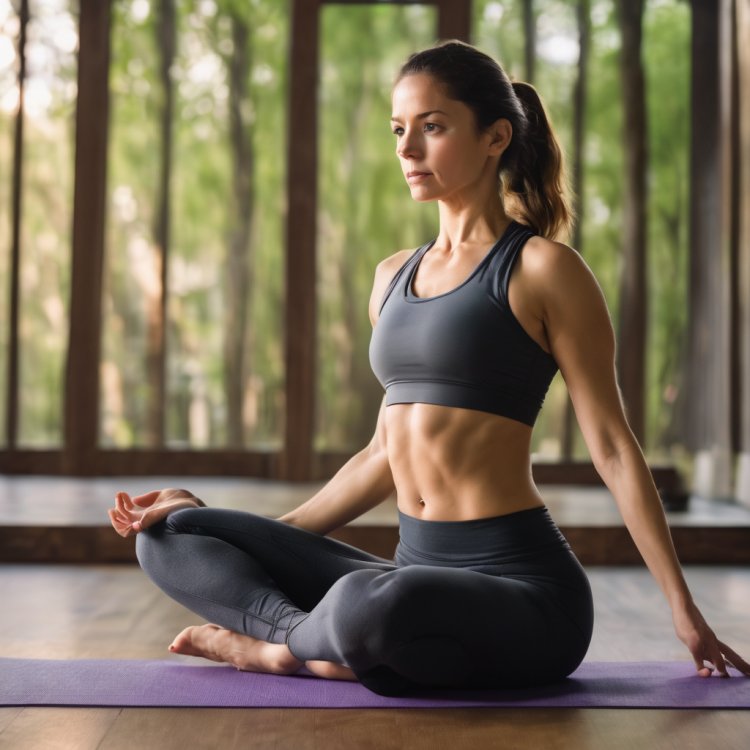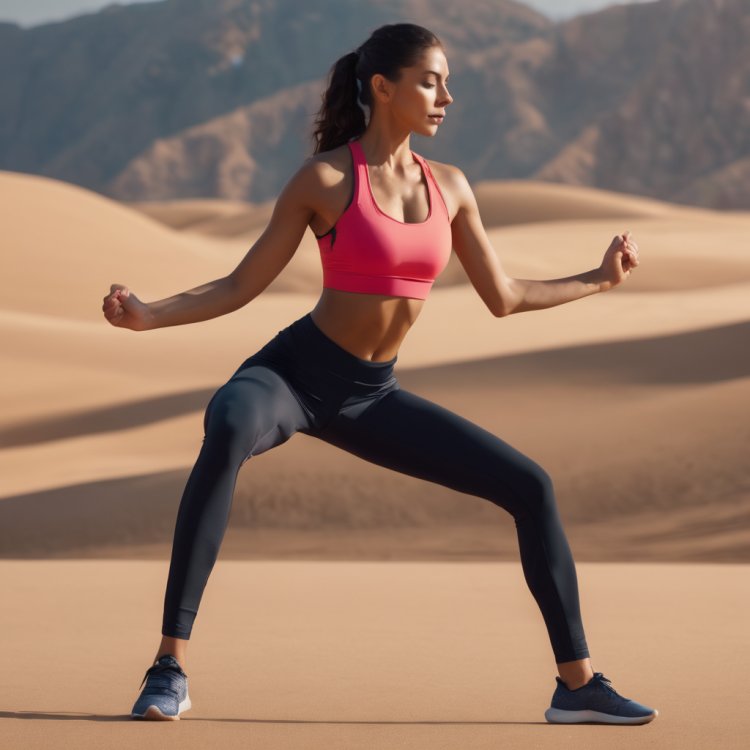Yoga For Runners: Strength & Mobility Sequence
Yoga for runners: Improve strength and flexibility with specific postures such as lunges, downward dogs, and pigeons, which assist in injury prevention and performance development.

WHAT IS YOGA FOR RUNNERS?
Yoga for runners is a basic yoga exercise designed to increase the flexibility and strength of the muscles utilized in running. It can assist you in improving your running form, lowering your chance of injury, and improving your overall performance. Although there are many different styles of yoga, runner-specific yoga sessions tend to focus on postures that expand the hips and chest while also lengthening the leg muscles. Yoga sessions designed specifically for runners can also help you improve your breathing and endurance. If you run and want to try yoga, seek a particularly tailored class or a yoga instructor who has worked with runners in the past.
YOGA'S PHYSICAL BENEFITS FOR RUNNERS
Yoga may assist in enhancing running performance, avoiding injuries, increasing mobility and flexibility, and so much more. Here are a few examples:
- Form improvement
- Improved operational efficiency
- Injury avoidance
- Stretching out any tense muscles
- Recovery time is reduced.
- Core muscle strength
According to studies, persons who practice yoga have a better running economy than those who do not. This improved form may result in a more efficient running economy, which is the amount of energy expended at a particular speed.

THE MENTAL BENEFITS OF YOGA FOR RUNNERS
Yoga, in addition to its physical benefits, may assist runners to enhance their mental game. Yoga breathing techniques can help calm tensions and alleviate anxiety before a race. Yoga practice may also help you be more present during runs, allowing you to focus on the job at hand rather than allowing your mind to wander.
Deep breathing exercises can assist in boosting mental stamina and physical endurance, both of which are required for long-distance running and sprinting. Many runners and professional athletes have benefited from including breathing and pranayama in their training plan, according to research.
KEY YOGA POSES FOR RUNNERS
Running is an excellent way to get in shape, but it can also be quite taxing on your body. Here are some yoga positions suitable for runners:
BODY POSE
This stance is great for resting and recharging your batteries. Simply lie on your back on the floor to do a corpse position. Close your eyes and concentrate on taking long, deep breaths. Allow your entire body to relax and cleanse your mind. Maintain this position for at least 5 minutes.
CHILD’S POSE
This position is excellent for relaxing the lower back and hips. To do a child's pose, you need to kneel on the floor. Then, place your forehead on the floor in front of you and stretch your arms. Deep breaths must be taken, and the position should be held for at least 30 seconds.
DOWNWARD DOG
This position will stretch your hamstrings and calves. Begin in a plank posture to do a downward-facing dog. Lift your hips into the air, forming an upside-down "V." Maintain a hip-width distance between your feet and a shoulder-width distance between your hands. Deep breaths should be taken, and the stance should be held for at least 30 seconds.
WARRIOR III
This position is excellent for core strengthening and increasing balance. Begin Warrior III in a standing position. Then, lunge forward with your left leg while lifting your right leg behind you. Stretch your arms out in front of you, keeping your attention fixed on a single place. Maintain this stance for at least 30 seconds after taking a big breath.
COBRA POSE
This pose is great for stretching your chest and shoulders. Begin the cobra stance by resting on your stomach. Next, place your hands on the floor next to your shoulders and push yourself up so that your upper body is off the floor. Keep your lower body on the floor and breathe deeply. Maintain this position for at least 30 seconds

TRIANGLE INSTALLATION
This position is excellent for growing the hips, thighs, and chest. To begin a triangle position, stand with your feet hip-width apart. Next, step forward with your right foot and lunge. Reach your right hand toward the floor next to your right foot. Extend your left arm in the air. Turn your gaze toward the ceiling and take a deep breath. Maintain this pose for at least 30 seconds.
HALF-MOON POSE
This pose stretches your hamstrings and calves. Start by standing with feet together and extending one leg. Next, step forward with your right foot and lunge. Reach your left hand toward the floor, next to your right foot, and place your right hand on your hip. Raise your left leg in the air and take a deep breath. Maintain this pose for at least 30 seconds.
CAT COW POSE
This familiar pose relaxes your back and neck. To perform the cat and cow pose, start by positioning yourself on all fours. Try arching your back and looking up at the ceiling like you're in a cow pose. Then, round your back and tuck your chin into your chest (cat pose). Alternate between these two yoga poses and breathe deeply. Maintain each pose for at least 30 seconds.
LOW LUNGE
The low lunge is well known for being a great hip opener, but it also stretches the groin and thighs. Tight hips are a common problem among runners, causing underactivity of the gluteal muscles and posing the risk of knee and/or back problems. To maintain this posture, it's important to focus your attention. It can be done against a wall to improve balance.
CAMEL POSE
You can expand your chest and shoulder region with this position. Start the camel pose by kneeling on the ground. ack and place your hands on your lower back.Use your right hand to hold your right ankle and your left hand to hold your left ankle. Take a deep breath and hold this pose for at least 30 seconds.
YOGA ASANAS RUNNERS SHOULD AVOID
Certain yoga poses should be avoided or approached with special attention. Poses to watch out for include:
PIGEON POSE
Since runners are prone to tight hips, hip flexors, and knees, the pigeon pose can be a difficult and intense pose that must be approached with caution. Many tend to reduce the intensity by compensating by pushing in the lower back. Feeling strange sensations in the knees during pigeon pose signals that something might be going on with the joints.
EAGLE POSE
Eagle pose incorporates multiple twisting joint movements, especially externally, which can amplify the intensity of knees already strained by high-impact running. The best way to practice this pose is to go slowly instead of forcing it.
FORWARD FOLDS AND FOLDS
Folds and squats are great hamstring stretches. However, runners who have excess tension in these muscles have a significant risk of overdoing it and overstretching the muscles if the poses are forced. As with Eagle Pose, it's best to go slow and breathe rather than reaching for the toes with force.
Runners should not completely avoid these asanas but should be careful to listen to their bodies and only go as far as they feel comfortable.
Finish the yogic practice by lying in a resting pose. Take a deep breath and rest while lying down on the yoga mat.
CAN YOGA HELP RUNNER’S KNEE?
A runner's knee is a frequent ailment that can result from a variety of circumstances. It generally causes discomfort around the kneecap and makes jogging and other activities difficult. Although a runner's knee can be extremely painful, there are some things you can do to relieve the pain and go back to running as soon as possible.
Yoga can improve a runner's knee by stretching and strengthening the muscles surrounding the knee, reducing discomfort and preventing future injury. Yoga's mild, muscle-strengthening postures can help athletes suffering from runner's knee (patellofemoral discomfort syndrome). Yoga before or after running can also help prevent runners' knees from developing in the first place.
Before beginning yoga, it is critical to determine whether or not you have a runner's knee. Begin by running a symptom checker for knee discomfort. The following symptoms may indicate patellofemoral pain syndrome or runner's knee:
- Back pain in the knee
- Knee pain while bending over
- Knee discomfort on the lateral side
- Knee discomfort in the front
Yoga before or after cardio can benefit folks with knee difficulties, but it is critical to visit a doctor beforehand. In general, the following yoga postures for runners, as well as other fitness suggestions, will assist in reducing knee discomfort if you are a runner:
- IT Band Stretches target the iliotibial band, which runs from the hip to the knee.
- Yoga quadrant stretches with a foam roller include crescent lunge, dancer's posture, camel hump, and bow hump.
- Yoga hamstring stretches include downward facing dog, portal position, firefly pose, moderate forward folds, and backbends.
- Standing dynamic split, soft pigeon and lizard position embracing knees stance, and joyful baby pose are all hip stretches for runners.

YOGA PRACTICE FOR RUNNERS: FAQS
WHAT KIND OF YOGA IS SUITABLE FOR RUNNERS?
There are many types of yoga, and each type can offer different benefits to runners.
- Hatha yoga is a good option for beginners or those who want to focus on improving their flexibility.
- Ashtanga yoga is a more physically demanding form of yoga that can help build strength and endurance.
- Bikram yoga is a type of hot yoga that can help detoxify and release tight muscles.
- Yin yoga is a good option for those looking to improve joint health because it involves holding poses for longer periods of time.
HOW TO START YOGA
There are a few things to remember. Begin with an introductory course. A yoga session for beginners will teach you the fundamentals of yoga and help you feel at ease with the practice. You can progress to a more advanced lesson once you've gained confidence.
It's also critical to listen to your body and not push yourself too hard. If you're searching for a yoga session designed expressly for runners, numerous gyms and studios offer such programs. You may also take online yoga courses from the convenience of your own home. Apps and platforms like Glo, Alo Moves, and Gaia provide a wide range of options for both beginners and expert practitioners.
YOGA OR PILATES: WHICH IS BETTER FOR RUNNERS?
It depends on your goals and your current workout routine. Pilates may be better because it tends to be more intensive than cross-training for strength and endurance. Yoga may be for you if your aims are to improve flexibility via improved warm-ups and cool-downs or to discover greater centering through concentrated, peaceful practice. Learn more about the differences between yoga and pilates.
WEIGHTS OR YOGA?
Strength training and yoga are two of the most frequent types of exercises that runners may engage in to enhance their performance and avoid injuries.
Strength training can help you increase strength and power, allowing you to run faster while avoiding injuries. It is important, however, not to overdo it, as excessive strength training might cause injury. Yoga can also help with stress management, which is a key contributor to injuries.
So, which is better? The answer will vary based on the runner and their goals. Strength training may be a preferable option for a runner looking to increase their speed.
What's Your Reaction?




















